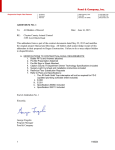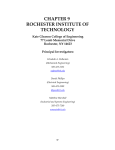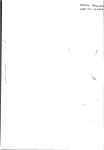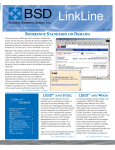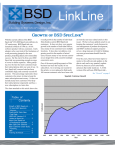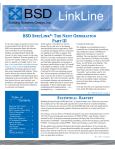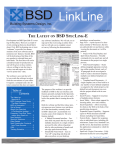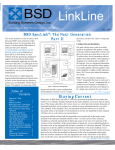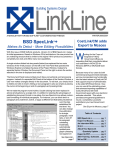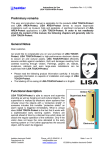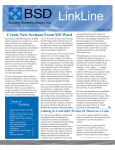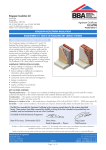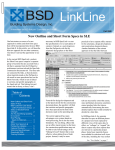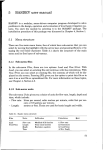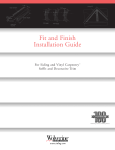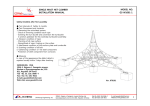Download LinkLine - Speclink
Transcript
LinkLine A Newsletter for BSD SoftLink ® Customers and Friends Changes in BSD SpecLink®/ PerSpective® Updating When users open an existing project for the first time after installing the latest release of BSD SpecLink, they will see a new dialog box. Instead of the familiar three choices that included the option not to update, the new Updating Options dialog has been simplified and now offers two possibilities. In response to the query “Do you want to update your project now?” users may choose either Yes or No. Selecting Yes activates a sub-option of whether to preserve and mark paragraphs that have been deleted from the master. If users select No (the default option), no changes are actually made to the project, but sections and paragraphs that would be affected by the update are color-coded to highlight them for later consideration. See “Changes in Updating” on page 7 Table of Contents A New BSD SpecLink! ......... 1 Changes in BSD SpecLink and PerSpective Updating .. 1 BSD Helps CJC, Inc ........... 2 About Your SpecLink & PerSpective Updates ....... 3 About the ASTM Updates .... 3 New Non-Proprietary Section List ......................... 4 Playground Surfacing Standard Has Changed ..................... 5 Q&A ..................................... 6 New Mechanical Sections for MasterFormat 2004 ....... 7 Training Schedule .............. 8 FALL 2004 A New BSD SpecLink®! The current release of BSD SpecLink presents the biggest single advance since the 32-bit version was released four years ago. Essentially, it’s a brand new product that will nonetheless look and feel familiar to our subscribers. reduced editing time. Decisions made early in a project on the PerSpective tab are linked to the Short Form tab, and selections on that tab are linked to the SpecLink tab, minimizing the need for re-entering data as the project moves from one phase to another. There are many changes, but two major innovations will be immediately apparent to users. The first of these new features is expanded scope. SpecLink now incorporates the data content of CSI-DBIA’s PerSpective®, resulting in a comprehensive database that can be effectively used to produce specifications for all phases of a project. The second major new feature in this release is a global choice on the Summary Info dialog box that allows users to switch any project between the 1995 MasterFormat™ organization and the new MasterFormat™2004 with a single mouse click. The global MasterFormat switch is unique to BSD SpecLink, and it’s the only spec product on the market that is even capable of this feat, because of its underlying database structure. Furthermore, the global switch allows all users to flip any project back and forth between the two formats at any time. Users of other commercial master systems like AIA’s Masterspec® will have to choose between two different sets of word processing files for new projects and will have to manually edit existing office master project files into MasterFormat 2004. They also won’t have the ability to switch their existing projects back to the earlier format once they have been edited, as SpecLink users can. SpecLink’s global MasterFormat switch, in addition to updating the navigation tree and the section numbers and titles as necessary, also automatically changes all internal cross references to the alternate system. The software even produces an automatically edited Table of Contents for each edition of MasterFormat. The expanded content has been organized on three tabs, which are displayed in the tree panel. Tab No. 1 is labeled PerSpective and includes performance specifications intended for use very early in a project, before any design has begun. Tab No. 2 is labeled Short Form and includes the Products portion of PerSpective. The abbreviated specifications produced on this tab are extremely useful at the schematic design and design development phases. Tab No. 3 is labeled SpecLink and comprises the content of the original BSD SpecLink product, intended for producing detailed specifications during the construction documents phase and administrative reports during the construction administration phase. Not only has the scope of SpecLink been expanded with this new release, but product selections made at each phase have been connected, for better coordination and In addition to the major innovations described above, the new release includes a number of further enhancements requested by our subscribers. These are described briefly below: • Save to Zip File: You can now save any project to a zip file, significantly reducing its size for back-up purposes and allowing it to be more easily emailed. See “A New SpecLink” on page 2 Figure 1 - BSD SpecLink Modules Provide Integrated Specs from Concept through Construction “A New SpecLink” continued from page 1 • Scrolling via Mouse Wheel: Both the tree panel and the document panel now allow scrolling by means of devices such as a mouse wheel. Simply click the panel and roll the wheel to scroll. • Right Mouse Button Menus: Depending on where you are focused, right mouse button menus now allow you to cut, copy, paste, and delete, among other actions. • Automatic Optimization: If your project needs to be optimized, it now occurs automatically as the project is opened. The Optimize Project menu command has been removed from the File menu. • Choice Pop-Ups Easier to Close: You can now click anywhere outside the choice pop-up box to close it, instead of being forced to click on the Close button. • Section Title Format: Section titles now appear in upper- and lower-case format in new projects, allowing you to choose between this format and all caps for printing. • New Quarterly Update: The Update function has been simplified (see related article in this edition of LinkLine). For a more complete description of all these changes, plus a number of others, we strongly suggest that you read the Version 7.0 Release Notes. These are included on the BSD SoftLink® CD-ROM, and they can also be downloaded from our website. Because this edition of BSD SpecLink is really a combination of PerSpective and the original BSD SpecLink+, subscribers to both products will install the same application. Users with subscriptions to both PerSpective and SpecLink will have access to the content of all tabs in the new consolidated product. Those who subscribe to SpecLink only will not be able to take advantage of the PerSpective and Short Form tabs, except for a few sample sections that have been unlocked for demonstration purposes. Likewise, subscribers to PerSpective or to the Short Form catalog will not be able to access the content of SpecLink. However, to encourage all our subscribers to take advantage of the full range of new capabilities, BSD has significantly reduced the cost of combined subscriptions. We’ll be happy to upgrade any subscriber at any time, and the entire process of obtaining a new access key can be completed in a matter of a few minutes over the telephone. We at BSD are very excited about this major new release of BSD SpecLink. The merging of two separate products into a more powerful software tool has required a significant commitment. In a little more than one quarter, we have upgraded the software, merged and updated the data, linked information on the separate tabs, and restructured the documentation and Help files. We are hopeful but confident that our users will be pleased by the results. Please let us know what you think. BSD SpecLink Helps Drive Quality and Innovation at ColemanJohnston-Clyma, Inc. In 1996 Larry Johnston, President and a Principal, decided that Coleman-JohnstonClyma, of Tulsa, Oklahoma, needed to dramatically speed up editing tasks and to reduce specification production time without compromising accuracy or integrity. SpecLink proved to be the answer. According to Johnston, “SpecLink freed up the time spent on the ‘busy,’ nonproductive decisions we were struggling with. Those functions have now been automated within SpecLink so that the staff can concentrate on the real issues of what materials and methods are best for the project at hand.” With minimal investment and training, CJC began to see immediate time-saving results. “This was very important to us because of the volume of project work we had to manage while trying to implement and learn a new system,” Johnston said. “We found the software easy to learn and very user friendly. My staff and I trained ourselves and were fairly productive in about two weeks. SpecLink is so easy to use, anyone can learn to use it in a fairly short time.” Initial set up and training were only the beginning of the time savings realized by CJC. The “point and click” method of selecting materials (versus deleting) made it See “SpecLink Helps CJC” on page 7 Review Committee Forming We received a very enthusiastic response to our invitation to subscribers to participate in the Technical Review Committee. Primary reviewers have been appointed for 16 topic-oriented subcommittees, such as “Exterior Closure,” “HVAC Equipment,” etc. The scope of each subcommittee will be established soon. A web-based “bulletin board” forum will be set up at BSD’s web site. All subscribers are welcome to comment. 2 BSD LinkLine Fall 2004 About Your SpecLink & PerSpective Updates SpecLink+ Statistics: • • • • • • • • • • 701 sections total, 439 updated or new (63%) 22 new non-proprietary sections 491 non-proprietary sections, 324 updated or new (66%) 210 proprietary sections, 115 updated (55%) 14 sections with built-in checklists 112,290 paragraphs 119,086 internal links (targets and consequences) 18,674 notes to specifier 3,200 notes with live hyperlinks to Internet web pages 2,113 external documents referenced • • • • • • 935 ASTM’s referenced, 31% revised 184 standards organizations referenced 4 new standards organizations 32 documents never before referenced 2,188 manufacturer listings in 346 nonproprietary sections 956 unique manufacturers listed in nonproprietary sections, of which 908 are not listed in proprietary sections Short Form Specs Statistics: • • • • 16 sections corresponding to MasterFormat 1995 divisions 14 sections updated (87%) 8,297 paragraphs 8,511 internal links (targets and consequences) About the ASTM Updates Standards published by the American Society for Testing and Materials (ASTM) make up 43% of the 2,212 documents referenced in SpecLink, the Short Form specs, and PerSpective — the largest number published by a single organization. All of those ASTMs were verified in the last quarter - 30% had been revised and 6 withdrawn. Each revised standard was compared to the previous edition and evaluated for its potential effect on the specifications, before updating the sections. The ASTM updates affected 43% of SpecLink sections, 14 of the 16 Short Form sections, and 12% of PerSpective performance specifying sections. Monitoring the continual, irregularly timed changes to ASTMs might be an almost impossible project, except that ASTM publishes an annual 4-volume compendium of the standards referenced in the model building codes, SpecLink and PerSpective, and other guide specifications — ASTM Standards in Building Codes. BSD provides ASTM with a list of standards biannually. BSD furnishes ASTM the information they need to ensure that all of the standards TCA Adds Another Member Benefit In a continuing effort to enhance and increase benefits available to its membership, the Tilt-Up Concrete Association (TCA) has embarked on a relationship with Building Systems Design, Inc. (BSD) – a firm that provides software and data products to architects, engineers, and contractors worldwide. Through this relationship, the TCA worked closely with BSD to revise the BSD SpecLink® language for Section 03470 – Tilt-Up Precast Concrete, (03 4713 - Tilt-Up Concrete), beginning with the fall 2004 update. TCA now endorses BSD SpecLink’s Section 03470 as a favorable • • • • 814 notes to specifier 365 external documents referenced, 4 obsolete documents removed 225 ASTM’s referenced, 46% revised 45 standards organizations referenced PerSpective Performance Specs Statistics: • • • • • • • 161 sections, 20 updated (12%) 17,361 paragraphs 21,552 internal links (targets and consequences) 3,282 notes to specifier 183 external documents referenced 49 ASTM’s referenced, 24% revised 37 standards organizations referenced referenced in non-proprietary SpecLink, Short Form, and PerSpective sections are included in this set. We use ASTMs in Building Codes as the “current” edition for purposes of referencing edition dates for one reason: It’s simple. We know that most design professionals don’t have copies of many, if not most, of the ASTMs referenced, so we’ve chosen as our definitive edition the simplest (as well as the most economical) way to purchase them. For $795, you get over 1,500 ASTM’s related to construction, in print and with a CD-ROM. There are three other ways to get ASTMs: Individually at an average of $30 per standard; individual volumes of the complete 78-volume set of all ASTMs at an average of $150 each; or the entire collection for over $7,000 in either print or CD-ROM. If you need only a single standard, ASTM’s web store makes it easy and quick to get the very latest edition. So, if you decide to add ASTMs to your reference library, we recommend ASTM Standards in Building Codes, published annually in early July, for $795. If you are not an ASTM member, you can get the 10 percent member discount if you place your order with Margie Lawlor at (610) 832-9616; tell her you are a BSD SpecLink/ PerSpective subscriber. For more information, go to www.astm.org. Tilt-Up specification guide and will provide further assistance in the maintenance and updating of future releases. BSD’s product will carry the TCA logo accompanying a statement endorsing the content. Part of the relationship forged with BSD includes the opportunity for the TCA to receive quarterly reports enumerating the projects that use the Tilt-Up Precast Concrete section, as well as hyperlinks from appropriate locations within the section to specific pages on TCA’s website (www.tilt-up.org). The Tilt-Up section of the program has been reviewed by TCA and includes content from the TCA See “TCA Member Benefit” on page 5 BSD LinkLine Fall 2004 3 New Non-Proprietary Sections 02225 (02 4100) BSD - Demolition: Building, site works, and selective demolition; abandonment of existing utilities. This section is one of two created from the former Section 02200 - Site Preparation (which has been withdrawn), to provide more complete coverage of demolition in Division 2. The “scope” listing in PART 3 can be used to describe items to be removed, ranging from entire buildings, to existing utilities, to minor site works like paving, curbs, and fences. Procedures for selective demolition for remodeling are included in this section, but the scope usually needs to be shown or itemized on drawings. If the only demolition applicable to the project is for alterations within an existing building, this separate demolition section may not be required — Section 01700 (01 7000) - Execution Requirements includes procedures for alterations work. 02230 (31 1000) BSD - Site Clearing: Vegetation clearing and protection; removal of existing debris and trash. This section is one of two created from the former Section 02200, Site Preparation (which has been withdrawn), to allow the site clearing to be located in Division 31 for Masterformat 2004. This section is applicable to virtually any project, unless the site is absolutely pristine (e.g. undeveloped and without vegetation to be preserved) or there is no open ground area on the site (e.g. fully developed urban site). The vegetation removal and protection requirements specified are based on preservation of natural vegetation, minimum site disturbance, and minimum waste removal, as described in the LEED Rating System. The provisions in this section, if followed, will justify 1 LEED credit. 07316 (07 3116) BSD - Metal Shingles: Aluminum, galvanized steel, and copper shingles for steep roofs, including underlayment and accessories. Installation of metal shingles is typically over a sheet underlayment on a plywood or other solid wood substrate. Accessories include metal flashing and counterflashing, which may be specified in this section or in a separate section on flashing. 07321 (07 3213) BSD - Clay Roof Tiles: Clay tile roofing for steep roofs, including underlayment and accessories. Installation of clay tiles is typically over a sheet underlayment on a plywood or other solid wood substrate. Clay tile may be installed on non-nailable substrates such as concrete deck by embedding wood nailing strips or by hanging the tiles with a wire tie system. Tiles may also be raised above the deck surface for better ventilation by nailing to wood battens. Accessories include metal flashing and counterflashing, which may be specified in this section or in a separate section on flashing. 07322 (07 3216) BSD - Concrete Roof Tiles: Concrete tile roofing for steep roofs, including underlayment and accessories. Installation of concrete tiles is typically over a sheet 4 BSD LinkLine Fall 2004 underlayment on a plywood or other solid wood substrate. Concrete tile may be installed on non-nailable substrates such as concrete deck by embedding wood nailing strips, or by hanging the tiles with a wire tie system. Tiles may also be raised above the deck surface for better ventilation by nailing to wood battens or using integral lugs to hang them from the battens without nailing (in areas where this practice is permitted by code). Accessories include metal flashing and counterflashing, which may be specified in this section or in a separate section on flashing. 08225 (08 1517) BSD - Fiberglass Doors and Frames: Heavy duty, FRP construction, for abuse and chemical resistance; fire-rated; FRP and metal frames. Fiberglass reinforced plastic (FRP) doors and frames withstand moisture, corrosive chemicals, and other harsh environments, yet require lower maintenance than comparable doors of other materials would need in the same installations. Most manufacturers offer fire-rated assemblies, up to 90 minutes; some require steel frames. Fiberglass doors and frames are made to order, to fit the exact dimensions of the door opening; the plastic resin is often custom formulated for specific chemical resistance; and custom colors and patterns are usually available. 08352 (08 3513.23) BSD - Folding Fire Doors: Horizontal sliding, accordion folding automatic-closing; up to 180 minute UL rating. This section describes Won-Door Corporation products only, because (as of 8/1/04) these are the only UL-labeled side-sliding or accordion folding fire doors made. The doors are automatically closed by a motor when activated by the fire alarm system or local fire or smoke detectors, which must be specified elsewhere. The fire door labeled products have optional exit hardware that allows a person to open the closed door and pass through, with the door closing again behind. 08385 (08 3815) BSD - Double Acting Traffic Doors: Self-closing swing doors for personnel, cart, and forklift traffic; bumpers, plates, optional frames. This section covers doors used to separate spaces while allowing easy passage for carts, forklifts, and people carrying things. The 5 types included are: 1) Molded polyethylene rigid panel, 2) Hollow core thermoplastic rigid and semi-rigid, 3) Solid wood core rigid panel, with many finishes, 4) Lightweight plastic or aluminum doors for personnel traffic only, and 5) Flexible sheet doors — “flapper” doors mainly for forklift traffic (hinged at top only). 11425 BSD - Hood and Ventilation Equipment (23 3813 - Commercial Kitchen Hoods): Grease extracting type, grease filter type, and condensate type; duct connections; hood fire extinguishing systems. This section covers the predominant types of hoods used in commercial kitchens, specified to SMACNA and NFPA 96 criteria. This section also See “New Section Synopses” on page 5 “TCA Member Benefit” continued from page 3 “New Section Synopses” continued from page 4 Guideline Specifications. One of the continuing benefits of this collaboration is TCA’s opportunity to submit new information and recommendations for improvements to the section on a quarterly basis. TCA members will be able to purchase a subscription to BSD SpecLink at a 15 percent initial discount and a five percent renewal discount. includes optional fire dampers, fire extinguishing systems for hoods, stainless steel ducts, and volume dampers for both make-up air and exhaust. Founded in 1983 with the mission to provide industry standard software for the architectural/engineering/construction (A/E/C) industry, BSD today offers a number of groundbreaking products. BSD SpecLink is a construction specification writing, management, and production system with built-in intelligence designed to help users dramatically speed up editing tasks and reduce specification production time while minimizing errors and omissions. SpecLink contains the industry’s most comprehensive and up-to-date database of master specifications, and includes lists of relevant building product manufacturers, appropriate reference standards, LEED/environmental issues, product selection guidance and more. It includes more than 700 sections covering all Construction Specifications Institute (CSI) Divisions, and the latest release includes a global switch that allows subscribers to switch any project between the current 16-division format and CSI’s brand new MasterFormat 2004. Performance requirements and short circuit and coordination study. This section describes studies required to be performed by the Contractor or his consultant, to determine whether the actual equipment to be provided (or existing) is adequately sized and the settings required to achieve selective coordination. This is not a substitute for analysis by the Architect/Engineer of overcurrent protection requirements or selection and specifying of adequate protective devices. “We are excited about this new relationship established with BSD,” said Jim Baty, TCA’s Technical Director. “The Tilt-Up section of the program has been thoroughly reviewed by our staff to add valuable language directly from the TCA Guideline Specifications. The ability to provide more guidance, education and quality for Tilt-Up projects through our involvement is a primary goal of the TCA and one we are glad to have the opportunity to cultivate through our relationship with A BSD SoftLink ® Publication BSD.” LinkLine Editor: Laura Gemmell The LinkLine is published by Building Systems Design, Inc. 3520 Piedmont Road, NE Suite 415 Atlanta, GA 30305 Permission to use excerpts in other publications is granted provided the publisher is notified in advance at 404-365-8900. BSD SpecLink, BSD CostLink and BSD SoftLink are registered trademarks, and BSD CadLink and BSD LinkMan are all trademarks of Building Systems Design, Inc. Get the latest on BSD by visiting our web page at www.bsdsoftlink.com According to Robert Paul Dean, AIA, CSI, president of BSD, “TCA’s participation in this new program is an affirmation of BSD’s commitment to providing our construction industry subscribers with the most current, technically correct guide specifications in the most sophisticated software available. We are very pleased to have TCA as a partner in that ongoing effort.” For more information about BSD SpecLink, visit www.bsdsoftlink.com or call (888) BSD-SOFT (888-2737638). 16051 (26 0573) BSD - Overcurrent Protective Device Coordination Study: Playground Surfacing Standard Has Changed ASTM F 1292 - Standard Specification for Impact Attenuation of Surfacing Materials Within the Use Zone of Playground Equipment: This standard measures the critical fall height for a particular depth or thickness of material — the new 2004 edition differs appreciably from the prior edition (1999). • For poured-in-place materials, the installed depth may need to be increased to achieve the original critical fall height. • For tiles and other types manufactured in a certain thickness, the critical fall height may be less than previously thought. • For loose fills, it may be possible to reduce the installed depth, because the test now requires the fill to be compacted to approximate actual (child-compacted) playground conditions, which has been found to actually increase impact attenuation of many loose fills. • For all types, the low-temperature test has been reduced to 25 degrees F (-6 degrees C), from 30 (-1). If low temperature performance is critical, it may be necessary to specify additional tests under those conditions. To determine critical fall heights, check with the specific manufacturer. Also, the International Play Equipment Manufacturers Association (IPEMA) certifies surfacing materials for specific depths and critical heights. To continue to be IPEMA-certified, materials must be re-tested under the new 2004 edition by mid-2006 — look for the edition date in the certification documents, or, better yet, refer to www.IPEMA.org, where all current certifications are listed. For sand and other natural fills that have no manufacturer per se, the playground designer must continue to rely on the Consumer Products Safety Council’s (CPSC) Handbook for Playground Safety, Pub. No. 325, for appropriate fill depths. BSD LinkLine Fall 2004 5 Access Key (unless you have not yet entered your renewal key). SpecLink & PerSpective I’ve heard that the next release of SpecLink will include PerSpective. Does that mean that I will get PerSpective for free? All Products What should I do when I get an error message? Contact BSD Technical Support. Email us at [email protected] or call 800-266-7732 (or 404-365-9226). When you call about an error, it is best if you are at the computer that is having the problem so that we can better troubleshoot and fix the problem. If you prefer email, you can email the text of the error message. BSD products create a log of error messages as you receive them. The log is called BSDERROR.LOG, and is located inside the User folder inside the directory on your local drive where your BSD software is installed. You can attach the entire log to your email, or copy and paste the relevant error into the email. The most recent errors are located at the end of the log. Please also describe what you were doing when the error occurred. I’m trying to install my update and I am getting ‘error during move data process.’ What does this error mean? The error usually means that the installation is unable to overwrite a file. To eliminate the error, first make sure no one is in the software. The update cannot be installed if any of the program files are in use. If someone’s computer crashed while the software was open, reboot that computer. Next, disable any antivirus software. And finally make sure you have full rights to the directory where you are installing the software. I never installed my update last quarter. What do I do? Install the most recent update over your current installation using the updated installation instructions on the CD or website. You do not need to install last quarter’s update, nor should you need a new The PerSpective database is now incorporated into the SpecLink software, but you will still need to subscribe to the PerSpective Performance Specification catalog or to the PerSpective Short Form catalog in order to gain access to them. Merging them together allows us (and you) to create links from the PerSpective catalogs to the SpecLink sections. I have a blue choice that is one character and I can’t open the choices dialog box. Why won’t it open? When there is a single-digit choice, you have to drag your mouse over the character in order for the dialog box to open. By the way, starting with the Fall 2004 release, you no longer have to click on the Close button to close the choice box. Clicking anywhere outside the box will automatically close it. What is the difference between demote and demote branch? When you demote or promote, you are changing just the one paragraph where your cursor is placed and moving it down or up a level. When you demote or promote a branch, you are changing the paragraph where your cursor is placed and any lower level paragraphs that are “children” to the current paragraph. If you have a number of like-level paragraphs in a row and want to change them all to a different level, you can highlight them all and either demote or promote the whole group at once. What is the difference between an access key and the serial code? The access key is what is provided to you to gain access to the data for which you subscribed. You get the access key when you initially subscribe after you install the product and call tech support with your access ID. When you renew your subscription annually, you will be emailed a new key that will provide access for another year. The serial code is only used when you download the quarterly updates from our website. This serial code is required during the installation process. It does not change each quarter and is the same for all users. It is included in the email that you get from Support each quarter when the update is ready to be downloaded. CostLinkAE and CostLinkCM I estimate many of the same type of building. Sometimes it is only the size of the building that changes. Is there a way to copy an old estimate and just change the size to change the cost of the estimate? Yes. You can use the linking features in CostLink/CM and CostLink/AE to link the quantity of tasks to their parent folders, and link the parent folders to their parent folders. You could also link to Excel where you would enter the size of the building and any other factors that would be used to determine the cost of a different building. See Chapter 8 of the CostLink/AE User Manual for more information on linking CostLink/AE to parent folder quantities and to Excel. See Chapter 10 of the CostLink/CM User Manual for a tutorial on linking Costlink/CM to Excel. How can I email my CostLink/CM or CostLink/AE reports to someone who does not have CM or AE? Export the report(s) to a PDF file, Excel file, Word file, or Rich Text Format (RTF) file. PDF files can be opened on any computer using Acrobat Reader and cannot be edited easily. Excel files can be edited in Excel, but keep in mind that the formulas are not exported; just the final report text and numbers will be in the Excel file. Word files can be edited in Word, and RTF files can be opened and edited in any word processor. To export your reports, Print Preview a report that you would like to email. In the Print Preview window, click on the export report button on the toolbar. Choose PDF, Excel, Word, or RTF. Follow the onscreen See “Q&A” on page 7 6 BSD LinkLine Fall 2004 “Q&A” continued from page 6 New Mechanical Sections for MasterFormat 2004 directions including entering a file name and location. Once the export is complete, you can email the exported file as an attachment. More questions? Contact BSD Technical Support: Toll Free: 800-266-7732 In Atlanta: 404-365-9226 Email: [email protected] ○ ○ ○ ○ ○ ○ ○ ○ ○ ○ ○ ○ ○ ○ ○ ○ ○ ○ ○ ○ ○ ○ ○ ○ ○ ○ ○ ○ ○ ○ ○ ○ ○ ○ “Changes in Updating” continued from page 1 The data we have collected on SpecLink usage over the past few months suggests that many subscribers are electing not to update their projects. This suggests to us that users may be confused about the effects of updating in SpecLink. In systems like AIA’s Masterspec® that are based on word processing, updating generally means replacing one file with another. If the earlier file has been edited, updating in a word processing system means that all your edits will be lost. That doesn’t happen with SpecLink. BSD’s unique updating scheme changes only selected paragraphs in the master database and does not affect the user’s project file, which is stored separately and “merges” with the master text only for viewing and printing. In SpecLink, when you open a project after updating it, all your added and edited text remains intact. Only individual paragraphs in the underlying master data have been changed to incorporate the updates, such as new edition dates of reference standards and the names of recently acquired product manufacturers. If you wish to review the updates before incorporating them into your project, choose No from the Updating options dialog. You should review and update your project as soon as possible—especially if it’s an office master project. Consistently choosing not to update your office master project(s) will result in out-of-date project specs and potential professional liability exposure. For more detail on the updating function in BSD SpecLink, please review the revised Chapter 11 of the BSD SpecLink User Manual, which is included on the quarterly CD-ROM and can also be downloaded from BSD’s website. Masterformat 2004 has divided Mechanical topics into three Divisions, with Common Work Results in each Division. • • • Division 21 Fire Suppression (from Division 13) Division 22 Plumbing (from Division 15) Division 23 HVAC (from Division 15) Common Work Results are what have traditionally been referred to as “basic materials and methods” and include items like insulation, hangers, vibration isolation, motors, identification, etc. In order to allow the same SpecLink master sections to be used under either Masterformat arrangement, new Common Work Results sections for Fire Suppression and HVAC have been created. The original Division 15 sections remain as-is for use in Masterformat 1995 for all 3 disciplines. In Masterformat 2004, the original sections will be used for Plumbing — unless the specifier wishes to use them for all three disciplines, by changing the title and scope, and crossreferencing the single section instead of three individual sections. At present, the new sections are simply copies of the original sections in Division 15. During the next quarter, each will be revised to cover only the relevant scope. The new sections are: • • • • • • • • • • • 13912 / 21 0513 - Common Motor Requirements for Fire Suppression Equipment 13914 / 21 0548 - Vibration and Seismic Controls for Fire Suppression Piping and Equipment 13915 / 21 0553 - Identification for Fire Suppression Piping and Equipment 13916 / 21 0719 - Fire Suppression Piping Insulation 15066 / 23 0513 - Common Motor Requirements for HVAC Equipment 15073 / 23 0548 - Vibration and Seismic Controls for HVAC Piping and Equipment 15076 / 23 0553 - Identification for HVAC Piping and Equipment 15083 / 23 0719 - HVAC Piping Insulation 15085 / 23 0716 - HVAC Equipment Insulation 15123 / 23 0516 - Expansion Fittings and Loops for HVAC Piping 15129 / 23 0519 - Meters and Gages for HVAC Piping “SpecLink Helps CJC” continued from page 2 easy to set up, manage, and change their “office master.” SpecLink will automatically include related text and exclude incompatible options, but allows the user to make changes at will. An unexpected advantage of SpecLink that CJC discovered over time was how it can be used as a training tool. Young interns with the firm used the “office master” that was set up, giving them the basic elements needed for common project specs. This allowed them to learn and became a basis for questions to further their understanding. It also gave the more experienced designers more possibilities (choices and selections) than they were able to see with other systems. Since making the switch to SpecLink and using it on over 100 projects, CJC estimates they experience savings of 40 to 70 percent, depending on the project. “Utilizing SpecLink for all of our projects is almost like having a spec consultant on our team,” summarizes Johnston. “The cost of the SpecLink subscription is well worth the investment as it has effectively increased our productivity by significantly reducing the man-hours required to write a spec and, at the same time, has greatly improved our accuracy. There are so many ways that SpecLink saves time, and in our business, time is money!” BSD LinkLine Fall 2004 7 Training Schedule The BSD SpecLink+ Workshop The BSD SpecLink+ Workshop consists of two one-day workshops. The first day is devoted to learning the basics of SpecLink+, including how to navigate within the software, start a new project, edit sections, understand how the links and choices work, and how to format, print and export the final document. It is designed for new users. The second day is designed for those who want to learn how to create and maintain their own office master. This day covers the concepts of an office master, how to customize your master by adding choices, links, and tags, as well as creating your own checklists. Users must already be familiar with the basics of SpecLink+ to attend the second day. BSD SpecLink+ BSD CostLink/CM Either Day* $495 Both Days* $895 3 days* $1295 Sept 7-8 Oct 5-6 Dec 7-8 September 21-23 December 14-16 2005 Feb 1-2 2005 March 1-3 June 7-9 AIA Members: Submit Course Completion Certificate for 7 or 14 Continuing Education Units CSI Members: Submit Course Completion Certificate for 7 or 14 Education Contact Hours (ECHs) toward your CCS, CCCA, or CCPR Certification renewal AIA Members: Submit Course Completion Certificate for 24 Continuing Education Units CSI Members: Submit Course Completion Certificate for 24 Education Contact Hours (ECHs) toward your CCS, CCCA, or CCPR Certification renewal * Class starts at 9:00 AM and ends at 5 PM. * Class starts at 9:00 AM and ends at 5 PM. View BSD class schedules on our website! Go to www.bsdsoftlink.com and click the Training link. Get directions & information on travel, hotels, & Atlanta! PRESORTED STANDARD U.S. POSTAGE PAID LinkLine 3520 Piedmont Road, NE Suite 415 Atlanta, GA 30305 ATLANTA, GA PERMIT NO. 6613








